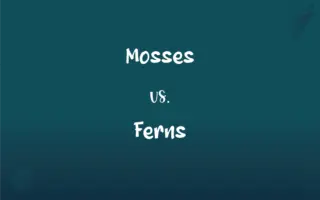Nail Polish vs. Enamel: What's the Difference?
Edited by Aimie Carlson || By Harlon Moss || Updated on October 16, 2023
Nail polish is a cosmetic product applied to nails for color or protection, while enamel can refer to a hard, glossy substance or the outer layer of teeth.

Key Differences
Nail polish is a cosmetic lacquer applied primarily to the fingernails and toenails to give them color or to protect them. On the other hand, enamel in dentistry refers to the hard, outermost layer of a tooth, protecting it from decay.
In the beauty industry, nail polish comes in a variety of colors and finishes, from matte to glittery. Whereas the term enamel in the same context can sometimes be used interchangeably with nail polish, especially when referring to a glossy finish.
The primary purpose of nail polish is aesthetic – to beautify or adorn the nails. Enamel, in broader terms, can be used in various contexts, including art where it's a material melted onto metal, glass, or ceramics to form a durable, decorative surface.
Nail polish usually consists of a mixture of an organic polymer and various other ingredients that give it its color and texture. In contrast, enamel when referring to the body, is the hardest substance and helps protect each tooth from daily wear and tear.
While both nail polish and enamel can be associated with protective functions (for nails and teeth, respectively), the contexts in which they are primarily used differ greatly – one being in cosmetics and the other in dentistry or arts.
ADVERTISEMENT
Comparison Chart
Primary Use
Cosmetic lacquer for nails
Outer layer of teeth or a hard glossy substance on art objects
Industry
Beauty/Cosmetics
Dentistry/Arts
Purpose
Aesthetic (color and protection for nails)
Protective (for teeth) or decorative (in art)
Composition
Organic polymers and pigments
Hard mineralized substance
Associated Terms
Matte, glossy, top coat
Hard, protective, glossy
ADVERTISEMENT
Nail Polish and Enamel Definitions
Nail Polish
A solution that dries to form a colored film on nails.
After applying the nail polish, she waited for it to dry.
Enamel
Often used interchangeably with nail polish in the context of a glossy finish.
She bought a new bottle of enamel for her nails.
Nail Polish
A cosmetic lacquer that can be applied to nails.
She chose a red nail polish to match her dress.
Enamel
The hard, outer protective layer of a tooth.
Regular brushing helps protect the enamel.
Nail Polish
A decorative solution for enhancing nail appearance.
Her blue nail polish stood out in the crowd.
Enamel
A paint that dries to a hard, glossy finish.
The artist used enamel to give the artwork a shiny look.
Nail Polish
A beauty product with varied finishes like matte or glossy.
She prefers matte nail polish over glossy ones.
Enamel
A material melted onto metal or ceramics to form a decorative surface.
The vintage pin was adorned with blue enamel.
Nail Polish
A protective coating for nails.
She applies nail polish to prevent her nails from chipping.
Enamel
A type of varnish used to create a glossy surface.
The table's top was coated with clear enamel for protection.
Enamel
A vitreous, usually opaque, protective or decorative coating baked on metal, glass, or ceramic ware.
Enamel
An object having such a coating, as in a piece of cloisonné.
FAQs
How is nail polish applied?
Nail polish is applied using a small brush from a bottle, typically in 1-3 coats, allowing each to dry in between.
How long does nail polish last?
It can last several days to weeks, depending on the product's quality and the wearer's activities.
Is nail polish harmful?
Most are safe, but some may contain chemicals like formaldehyde, which can be harmful with excessive exposure.
Can men wear nail polish?
Absolutely, nail polish is not gender-specific.
What is enamel in general context?
Enamel typically refers to a hard, glossy, and opaque substance used for coating materials for protective or decorative purposes.
Can you use enamel paint on nails?
No, it's not safe or formulated for use on the body.
Does nail polish expire?
Yes, it typically lasts 1-2 years from opening before consistency and quality degrade.
Can enamel be repaired?
Once lost, tooth enamel cannot regenerate, but damaged enamel can be restored with medical interventions.
What is nail polish?
Nail polish is a cosmetic product used to color and protect the fingernails and toenails.
Does nail polish have other functions?
Besides aesthetics, it can protect nails from damage and breakage.
Can nail polish be removed?
Yes, using a solvent like acetone or nail polish remover.
Is nail polish vegan?
Some brands are vegan, but consumers should check individual products for animal-derived ingredients.
What is tooth enamel?
It's the hard, outer surface layer of your teeth that serves to protect against decay.
Is enamel paint different from regular paint?
Yes, it's tougher, glossier, and more durable, designed for surfaces needing resilience.
What's "enamel" in "nail polish"?
In this context, "enamel" is another term for nail polish—it doesn't refer to the substance found on teeth.
Is enamel safe for enamel cookware?
Generally, yes, but check the manufacturer's guidelines, especially concerning oven use.
How is enamel made?
It's typically created by fusing powdered glass to a substrate by firing, usually between 750 and 850 °C.
Does enamel contain lead?
Some traditional enamel might, but most modern enamel, especially for cookware or cosmetics, is lead-free for safety.
Are there different types of nail polish?
Yes, including matte, gel, glitter, and more.
How do you care for enamel cookware?
Avoid sudden temperature changes, don't use metal utensils, and avoid abrasive cleaners.
About Author
Written by
Harlon MossHarlon is a seasoned quality moderator and accomplished content writer for Difference Wiki. An alumnus of the prestigious University of California, he earned his degree in Computer Science. Leveraging his academic background, Harlon brings a meticulous and informed perspective to his work, ensuring content accuracy and excellence.
Edited by
Aimie CarlsonAimie Carlson, holding a master's degree in English literature, is a fervent English language enthusiast. She lends her writing talents to Difference Wiki, a prominent website that specializes in comparisons, offering readers insightful analyses that both captivate and inform.






































































